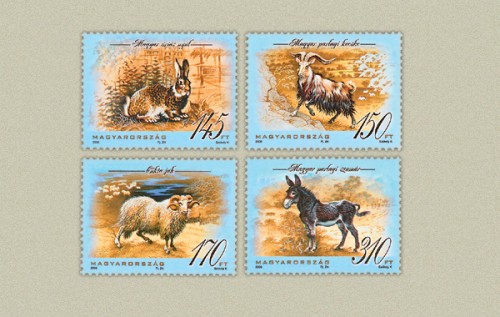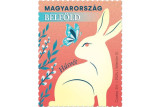
1. MAGYAR - ÉLŐ ÖRÖKSÉGÜNK IV. - SOR - Bélyeg rendelési kód: 2008 év bélyegei kompletten
2. ENGLISH - OUR LIVING HERITAGE IV. - ROW - Order code of the stamp: 2008 Year stamps complete
3. GERMAN - Living Heritage IV. - ROW - Die Bestellnummer Der Marke: 2008 Jahr Briefmarken komplett
1. MAGYAR - ÉLŐ ÖRÖKSÉGÜNK IV. - SOR
A Magyar Posta hagyományszerűen postabélyegeken mutat be néhányat az őshonos hazai állatfajták közül.
A házi bivaly több mint ezer éve él ezen a területen. A bivaly mai fogalmaink szerint hármas hasznosítású. Magas zsírtartalmú tejet és húst termel, valamint igaerőt szolgáltat. A megszokott gondozóval szemben engedelmes és jóindulatú, általában félénkebb, mint a szarvasmarha. Tekintettel arra, hogy déli származású faj, nálunk csak zárt istállóban tud áttelelni. Az állati igaerő háttérbe szorulásával számuk Magyarországon jelentősen lecsökkent, ma, mint genetikai tartalékot és kultúrtörténeti emléket őrizzük.
A magyar óriás nyúl őse a magyar parlagi és vadas nyúl mellett a hazánkba hozott belga óriás nyúl volt. Takarmányozása főként abrakkal és nagy mennyiségű fonnyasztott zöldtakarmánnyal végezhető. Négy színváltozatban tenyésztik. A fül a külső szélén és a hegyén feketés árnyalatú. A szőrzet minden testtájon egyenletes színeződésű. Kifejlett korban a testsúlya 5,5–7 kg közötti. 1994-ben vették fel az őshonos állatok listájára. Napjainkban mindössze pár száz példány lehet.
A magyar parlagi kecske egyike őshonos, törvényileg védett háziállatainknak. Parlaginak azért nevezik, mert nem tudatos tenyésztői munka eredményeképpen jött létre. Feltehetőleg honfoglaló elődeink hozták magukkal és az itt élő népek kecskéivel történő keresztezésből alakult ki a szilárd szervezetű, jó alkalmazkodó képességű fajta. Színváltozatai az ordas, a szürke, a fehér, a tarka, a vadszín, nyáron a vöröses szín, a háton sötét szíjazással. A bakokra jellemző a felfelé álló pödrött szarv.
A cikta juh magyarországi története a török hódoltság után kezdődött, amikor az elnéptelenedett területekre német ajkú lakosságot telepítettek. Ők hozták magukkal a ciktát, melynek testét hosszú fürtű, durva, fehér színű gyapjú fedi. Eredeti hazájában, Németországban teljesen kipusztult, s ez külön fontosságot ad a magyarországi állománynak, hiszen néhány bemutató példánytól eltekintve csak egyetlen nyáj van ebből a fajtából. Gazdasági haszna ma már nincs, tartásának elsődleges célja a génmegőrzés.
A magyar parlagi szamár története időszámításunk kezdetéig nyúlik vissza, hiszen az első szamarak a kelták idejében kerültek a Kárpát-medencébe. Soha nem tenyésztették, az állomány mindig természetes szaporulat útján gyarapodott. Színe változatos. A fajta legértékesebb tulajdonsága a betegségekkel szembeni ellenálló képesség, az igénytelenség, a szívósság, a békés természet, a munkabírás és a sokoldalú hasznosíthatóság. 2004-ben ismerték el önálló fajtaként.
A bélyegképeken névérték szerinti sorrendben magyar óriás nyúl, magyar parlagi kecske, cikta juh és magyar parlagi szamár látható. Az alkalmi borítékot a pásztorművészetet idéző ornamentikus állat- és növényábrázolás díszíti. Az alkalmi bélyegző főmotívuma a magyar parlagi kecske és a cikta juh stilizált rajza.
Megjelenési időpont: 2008. május 9.
Forrás: Philatelia Hungarica Kft., Magyar Posta
2. ENGLISH - OUR LIVING HERITAGE IV.
Magyar Posta has a tradition of presenting some of Hungary’s indigenous domestic animals on postage stamps.
Water buffalo have lived in this area for over a thousand years. Today water buffalo are kept for three uses: for their milk rich in fat and their meat, and as a draught animal. They are obedient and welltempered with the keeper they are used to, and are usually shier than cattle. As they are a species of southern origin, in Hungary they have to be overwintered in a closed stable. With the decrease in use of draught animals, their number fell significantly in Hungary, and today they are kept as a genetic reserve and pre-served as part of cultural history.
The ancestors of the Hungarian giant rabbit were two species of Hungarian wild rabbit and the Belgian giant rabbit brought into Hungary. It is fed with hard fodder and large quantities of herbage. It is bred in four colour variations. The ears have blackish shading on the outer edges and on the tips. The fur is even coloured on all parts of the body. The mature rabbit weighs between 5.5–7 kg. It was accepted on the list of indigenous animals in 1994. Today there are only a few hundred of this species remaining.
The Hungarian domestic goat is one of our legally protected indigenous domestic animals. It is not the result of conscious breeding. Presumably it was brought by the Magyar tribes when they settled in Hungary, and as a consequence of crossing with the goats of local peoples this solidly built adaptable species developed. Its colour varies between dun, grey, white, speckled and brownish grey, while in summer it is reddish with a dark stripe on its back. Twisted horns pointing upwards are typical of the billy goats.
The history of cikta sheep in Hungary started after the Turkish occupation, when German-speaking people were settled in depopulated areas. They brought cikta sheep with them, which has a long, coarse, white fleece. In its original homeland, Germany, it has become extinct, which gives special importance to the stock in Hungary, as apart from a few isolated examples there is only one flock left of this breed. It has no economic use any more and is now kept primarily to preserve its genetic stock.
The history of the Hungarian donkey goes back to the Beginning of the Common Era as the first donkeys were brought to the Carpathian Basin by the Celts. They were never bred and they always reproduced naturally. Their colours are varied. Their most valuable qualities are resistance to illness, hardiness, peaceful temperament, sturdiness, adaptable use, and undemanding care. They were recognised as a separate breed in 2004.
On the frame and stamp design of the block there are water buffalos as part of a graphic composition recalling the environment typical of them. As with the block, each animal of the stamps of the set appears with motifs referring to its habitat and environment. The stamps show in ascending order of face value the Hungarian giant rabbit, the Hungarian domestic goat, cikta sheep and the Hungarian donkey. The first day cover is illustrated by ornamental animal and floral decorations recalling pastoral art. The main motif of the commemorative postmark is the stylised drawing of the Hungarian domestic goat and cikta sheep.
Date of issue: 9 May 2008
3. GERMAN - Living Heritage IV. - ROW
Die Ungarische Post postabélyegeken hat eine Geschichte zu präsentieren, einige der einheimischen Haustierrassen.
Die Wasserbüffel für mehr als tausend Jahre in diesem Bereich. Der Büffel heute bekannt, dass die drei Begriffe verwendet. Fettreiche Milch und Fleisch zu produzieren und liefern igaerőt. Die Klinik gegen die üblichen gutmütig und folgsam, in der Regel bescheiden, wie das Vieh. Da die südlichen Arten von Herkunft, können wir nur Schuppen im Winter geschlossen. Das Tier igaerő Hintergrund szorulásával Zahlen haben sich in Ungarn, heute, wie eine genetische Reserve verringert und die Bewahrung des kulturellen Denkmäler.
Der Vorfahr des Riesen Kaninchen Ungarisch Ungarisch Hauskaninchen und Wild zu unserem Land gebracht, der belgischen Riesen Kaninchen. Fütterung hauptsächlich Grafiken und große Mengen an Grünfutter kann welk. Vier Farben gezüchtet. Der äußere Rand des Ohres und der Spitze schwärzlichen Farbe. Das Fell ist glatt Kürzungen in allen Farben. Erwachsene im Alter von 5,5-7 kg Gewicht. Im Jahr 1994 wurden in der Liste der einheimischen Tieren enthalten. Heute, nur wenige hundert Exemplare werden kann.
Die ungarische Muttersprache ist eine der Hausziege von Haustieren durch das Gesetz geschützt. Parlaginak so genannt, weil sie nicht bewußt sind Ergebnis der Zuchtarbeit. Vorfahren waren wahrscheinlich und die Leute des Kreuzes Ziegen gebracht entwickelten eine starke Verfassung, gute Anpassungsfähigkeit der Vielfalt. Farbe des braunen, grau, weiß gefärbt, vadszín Sommer, die rötliche Farbe, dunkle szíjazással zurück. Die bakokra zeichnet sich durch pödrött bis auf die Hupe.
Die Schafe cikta Geschichte Ungarns nach der türkischen Besetzung begann, als deutsch-sprechenden Bevölkerung in den entvölkerten Gebieten angepflanzt. Sie brachten die cikta, dessen Körper wuchs in vertikalen Clustern aus langen, groben weißen Baumwollbezug. Original Land ist Deutschland völlig zerstört, und das gibt besondere Bedeutung bei der ungarischen hat, mit einigen Anzeigen példánytól abgesehen davon gibt es nur eine Herde in Form von Sachleistungen. Die wirtschaftliche Vorteilhaftigkeit ist nicht mehr zu halten der Hauptzweck des Gens.
Die ungarische Esel Geschichte reicht zurück bis zum Beginn unserer Zeitrechnung, denn zum ersten Mal die Kelten waren Esel im Karpatenbecken. Ich habe noch nie in der Herde gezüchtet hat immer durch das natürliche Wachstum bereichert. Seine Farbe ist unterschiedlich. Die wertvollste Eigenschaft dieser Art der Resistenz gegen Krankheiten, die Bescheidenheit, die Zähigkeit des friedlichen Charakters der Arbeitsbelastung und die Vielfalt der nutzbaren. Im Jahr 2004 als eigenständige Rasse anerkannt.
Der Nominalwert der Briefmarken in der Reihenfolge der ungarischen Riesen Kaninchen, Ungarisch inländischen Ziegen, Schafe und Esel cikta ungarischen gesehen werden kann. Envelope, in denen das gelegentliche Schäfer ornamentikus Tier-und növényábrázolás eingerichtet. Die gelegentliche Stempel főmotívuma der ungarischen nationalen Ziegen und Schafe cikta stilisierte Zeichnung.


